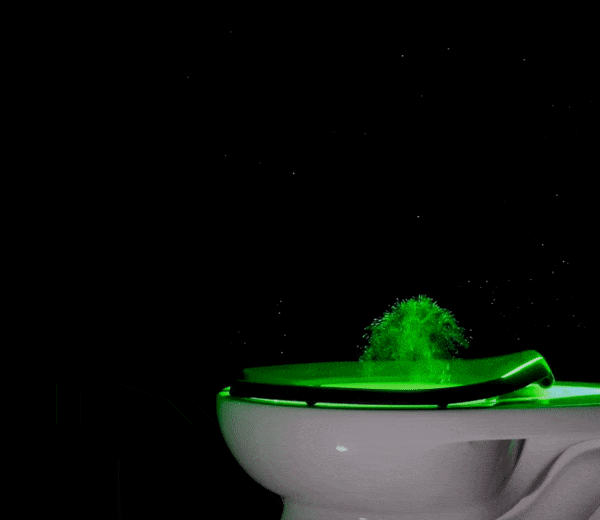Here’s What Really Happens When You Flush a Toilet
Using lasers and cameras, scientists visualized the plume of tiny, aerosolized particles ejected from commercial toilets during flushing

With the press of a handle and a powerful whoosh of water, toilets send waste far away from humans and down into the sewer system. But new research shows—in surprising detail—just how much waste they also spew into the air, potentially spreading contagious diseases in the process.
Scientists have known for decades that, when flushed, toilets expel small particles of water, urine, feces and, at times, dangerous pathogens that are invisible to the naked eye. But researchers haven’t been able to see the airborne particles, nor understand how and where they spread.
Researchers at the University of Colorado Boulder wondered if they could use lasers to visualize this aerosol plume and measure the trajectory and speed of the toilet-borne particles. They set up green laser beams over a commercial toilet without a lid, positioned two cameras a few feet away, dimmed the lights and flushed. The lasers illuminated the tiny particles ejected by the toilet, allowing the scientists’ eyes and the cameras to clearly see the resulting spray.
Their eerie green videos show just fast and far these particles are likely flying in public bathrooms—which typically have lid-less toilets—around the world, possibly putting bathroom-goers at risk of getting sick. They shared the findings of their bathroom experiment in a new paper published last week in the journal Scientific Reports.
“If it’s something you can't see, it’s easy to pretend it doesn’t exist,” says study co-author John Crimaldi, an engineer at the University of Colorado Boulder, in a statement. “But once you see these videos, you’re never going to think about a toilet flush the same way again.”
The researchers are physicists and engineers—not epidemiologists—but they hope their learnings may someday help prevent the spread of toilet-dwelling bacteria and viruses, including Legionella, noroviruses, E. coli and C. difficile. After an infected person uses the toilet, the pathogens can remain in the bowl even after dozens of flushes. When expelled into the air during a flush, the viruses and bacteria may then make their way into the lungs of subsequent bathroom-goers.
During the experiment, airborne particles ejected from the toilet traveled at speeds of up to 6.6 feet per second and reached 4.9 feet above the toilet within eight seconds, the scientists found. And, once airborne, smaller particles measuring less than 5 microns hung in the air for more than a minute.
“Most people don’t realize there are fine particles everywhere,” says Evan Floyd, an occupational and environmental health scientist at the University of Oklahoma who was not involved in the study, to Inverse’s Max G. Levy. “It’s nice to have the quick visualization.”
The particles primarily traveled upward and backward toward the wall behind the toilet, but some also moved chaotically in other directions. Once airborne, some particles traveled up to the ceiling, then spread out along the wall and into the room, the researchers noted.
The toilet they used in the study was brand new, clean and filled only with tap water, and the researchers write that the presence of fecal matter and toilet paper could affect the trajectory of the aerosol plume. They also performed their flushing experiments in a ventilated laboratory without any partitions and noted that the results may be different in a public restroom with stalls.
However, based on the laboratory findings alone, bathroom designers and plumbers may want to adjust the mechanics of public toilets or install better ventilation or disinfection systems to help prevent the spread of disease. And if these experts choose to develop and test such innovations, this experiment’s green laser light setup could provide a viable way to do that, the researchers say.
“Being able to see this invisible plume is a game-changer,” says Crimaldi in the statement. “None of those improvements can be done effectively without knowing how the aerosol plume develops and how it’s moving.”
/https://tf-cmsv2-smithsonianmag-media.s3.amazonaws.com/accounts/headshot/SarahKuta.png)


/https://tf-cmsv2-smithsonianmag-media.s3.amazonaws.com/accounts/headshot/SarahKuta.png)